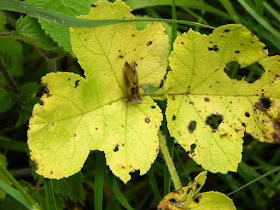 |
| Burnished Brass Moth (Diachrysia chrysitis) |
So here are the facts:
- The Wingspan ranges from 28mm - 35mm and the fore-wing ranges from 16mm - 18mm.
 |
| It was sat on this lighter coloured leaf among all the darker leaves. |
- As we discovered they are fantastic at camouflaging themselves and their colouring blends in perfectly with leaves as they are brown and green, and have a slightly metallic appearance which is where they get their name from I think. There were lots of darker leaves around but the moth had picked on almost the same colour as it.
- They are found all over the UK though they are less common in Northern Ireland and Wales.
- I have noticed that I have quite a Global Audience so I thought I would write about where they are found around the rest of the World such as in Russia, Siberia, and Europe...
 |
| A moths eye view. |
- ...including Spain, Southern Italy, The Caucasus Islands, and even in Japan and the Arctic Circle!
- This species lays two broods between June and September most commonly.
- The Larvae feed on plants such as Nettle and Marjoram where their eggs are laid. They can also eat and thrive on Red Valerian, Thistles and Buddleia.
- The Larvae hatch in late Summer, they feed for a while and then hibernate when they are quite small. They usually hibernate in leaf litter around a food-plant.
- Around April, Caterpillars wake up and start eating again. Then in May they will form a cocoon underneath a leaf, folding its edges around it.
 |
| It was doing a handstand - how do their arms or legs not get tired? |
- After about 4 weeks the Adult then emerges, this stage is where it eats a bit more, breeds and then the cycle starts again.
Here are some links to some more information:
Hope you enjoyed,
Z.
Beautiful photos as always Zach! - Tasha
ReplyDelete